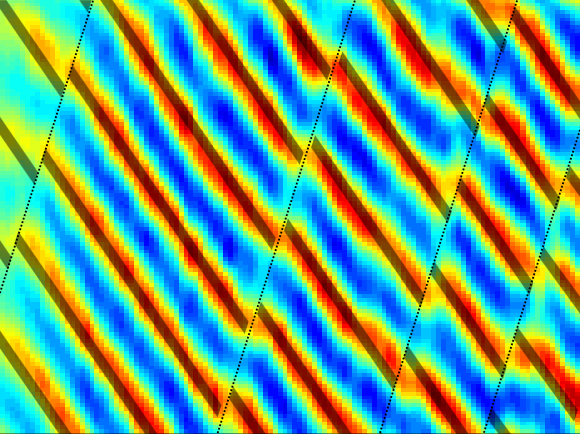Physicists have reported what could be the first incontrovertible evidence for the existence of unusual particle-like objects called anyons, which were first proposed more than 40 years ago. Anyons are the latest addition to a growing family of phenomena called quasiparticles, which are not elementary particles, but are instead collective excitations of many electrons in solid devices. Their discovery—made using a 2D electronic device—could represent the first steps towards making anyons the basis of future quantum computers.
“This does look like a very big deal,” says Steven Simon, a theoretical physicist at the University of Oxford, UK. The results, which have not yet been peer-reviewed, were posted on the arXiv preprint repository last week.
Known quasiparticles display a range of exotic behaviours. For example, magnetic monopole quasiparticles have only one magnetic pole—unlike all ordinary magnets, which always have a north and a south. Another example is Majorana quasiparticles, which are their own antiparticles.
Anyons are even more strange. All elementary particles fall into one of two possible categories—fermions and bosons. Anyons are neither. The defining property of fermions (which include electrons) is Fermi statistics: when two identical fermions switch spatial positions, their quantum-mechanical wave—the wavefunction—is rotated by 180º. When bosons exchange places, their wave doesn’t change. Switching two anyons should produce a rotation by some intermediate angle, an effect called fractional statistics that cannot occur in 3D space, but only as collective states of electrons confined to move in two dimensions.
Fractional statistics
Fractional statistics is the defining property of anyons, and the latest work—led by Michael Manfra, an experimental physicist at Purdue University in West Lafayette, Indiana—is the first time it has been measured so conclusively.
The quasiparticles’ unusual behaviour when switching places means that if one moves in a full circle around another—equivalent to the two particles switching positions twice—it will retain a memory of that motion in its quantum state. That memory is one of the telltale signs of fractional statistics that experimentalists have been looking for.
Manfra and his team manufactured a structure consisting of thin layers of gallium arsenide and aluminium gallium arsenide. This confines electrons to move in two dimensions, while shielding them from stray electric charges in the rest of the device. The researchers then cooled it to 10,000ths of a degree above absolute zero and added a strong magnetic field. This produced a state of matter in the device called a ‘fractional quantum Hall’ (FQH) insulator, which has the peculiarity that no electric current can run in the interior of the 2D device, but can run along the edge. FQH insulators can host quasiparticles whose electric charge is not a multiple of the electron charge, but instead is one-third of it: these quasiparticles have long been suspected to be anyons.
To prove that they were indeed anyons, the team etched the device so that it could carry currents from one electrode to another along two possible edge paths. They tweaked the conditions by varying the magnetic field and adding an electric field. These tweaks were expected to create or destroy anyon states stuck in the interior, and also to produce anyons running between the electrodes. Because moving anyons had two possible paths, each producing a different twist in their quantum-mechanical waves, when the anyons reached the end point, their quantum-mechanical waves produced an interference pattern called pyjama stripes.
This pattern shows how the relative amount of rotation between the two paths varies in response to changes in the voltage and the magnetic-field strength. But the interference also displayed jumps, which were the smoking gun for the appearance or disappearance of anyons in the bulk of the material.
“As far as I can tell, it is an extremely solid observation of anyons—directly observing their defining property: that they accumulate a fractional phase when one anyon travels around another,” Simon says.
It is not the first time that researchers have reported evidence of fractional statistics. Robert Willett, a physicist at Nokia Bell Labs in Murray Hill, New Jersey, says that his team saw “strong evidence” for fractional statistics in 2013.
And other teams have probed a different property that makes anyons an intermediate between fermions and bosons. Fermions obey the Pauli exclusion principle: no two fermions can occupy exactly the same quantum state. But bosons have no such restrictions. Anyons are in the middle—they do bunch, but not as much as bosons do, as an experiment described in April in Science reported. “It is strikingly different from the fermionic behaviour that we can also probe in the same set-up,” says Gwendal Fève, an experimentalist at the Sorbonne University in Paris who led that effort.
Quantum computing
But some theoretical physicists say that the evidence in these and other experiments, although striking, was not conclusive. “In many cases, there are several ways of explaining an experiment,” says Bernd Rosenow, a condensed-matter theorist at the University of Leipzig in Germany. But the evidence reported by Manfra’s team, if confirmed, is unequivocal, Rosenow says. “I’m not aware of an explanation of this experiment which is plausible and does not involve fractional statistics.”
The results potentially lay the groundwork for applications for anyons. Simon and others have developed elaborate theories that use anyons as the platform for quantum computers. Pairs of the quasiparticle could encode information in their memory of how they have circled around one another. And because the fractional statistics is ‘topological’—it depends on the number of times one anyon went around another, and not on slight changes to its path—it is unaffected by tiny perturbations. This robustness could make topological quantum computers easier to scale up than are current quantum-computing technologies, which are error-prone. Microsoft (which employs Manfra as a consultant) has been alone in pursuing the topology path for quantum computing, whereas other large companies, including IBM, Intel, Google and Honeywell, have invested in alternative approaches.
Topological quantum computing will require more-sophisticated anyons than those Manfra and colleagues have demonstrated; his team is now redesigning its device to do just that. Still, anyon applications are some way off, researchers warn. “Even with this new result, it is very hard to see [fractional quantum-Hall] anyons as a strong contender for quantum computing,” Simon says.
But the quasiparticles’ unique physics is worth exploring: “To me, as a condensed-matter theorist, they are at least as fascinating and exotic as the Higgs particle,” says Rosenow.
This article is reproduced with permission and was first published on July 3 2020.



